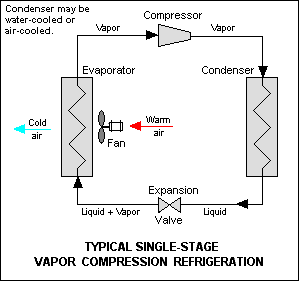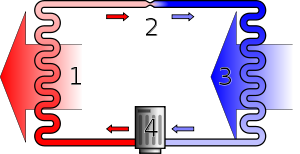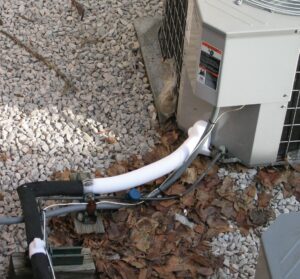In a refrigeration system, normal discharge pressure is defined as the pressure at which condensation takes place as per the design
At the normal discharge pressure, it is assumed that the refrigeration would be most energy efficient and there would be no fouling in the condensing circuit. Operating a compressor at significantly away from the normal discharge pressure values might be detrimental to compressor’s health.
For a compressor to operate at normal discharge pressure, following must be fulfilled:
- Right amount of refrigerant: The quantity of the refrigerant loaded must be correct. Too high a refrigerant load increases the discharge pressure and too low a refrigerant load decreases the discharge pressure.
- Both suction and discharge valves of compressor must be leak proof: If the discharge valve is passing a part of refrigerant would sneak back into the cylinder and keep recirculating inside the compressor increasing the discharge temperature and reducing the discharge pressure.Similarly, if the suction valve is passing there will be malfunction in the compressor upstroke.
- The compressor piston rings should not leak: IF the discharge gases leaks through the piston rings it leads to lower discharge pressure.
- Condenser should not be in fouled condition: A fouled condenser leads to higher discharge pressure because of inefficient cooling
- Sufficient cooling utility: Even if the condenser is fine, insufficient cooling water flow and temperature for a water cooled system and high ambient temperature for air cooled system may lead to higher than normal discharge temperatures.
What is Normal Discharge Pressure?
Normal discharge pressure is defined as the pressure at the discharge of refrigeration compressor, for which the refrigeration system is designed.
Since at the discharge of the refrigeration compressor the condenser is located, normal discharge pressure can also be defined as the pressure at which the refrigerant condenses with specified amount of sub-cooling at the available cooling utility.

Thus, the normal discharge pressure depends upon the refrigeration system, which includes the refrigerant in use and temperature of cooling utility.
If cooling utility is air, the discharge pressure would depend on specified ambient air temperature and it cooling utility is water, then it shall depend upon the available cooling water temperature.

The discharge pressure would also depend upon the type of refrigerant use.
The efficiency of refrigeration system in terms of power consumption are highest when operating at normal discharge pressure providing optimum cooling capacity for which it is designed.
However, for example, normally the Ammonia based refrigeration systems are designed for normal discharge pressures of 95-100 Psig.
Normal Discharge Pressure Cause
Normal discharge pressure is the default pressure of a refrigeration system and it is more important to ponder what causes the discharge pressure to increase.
Speaking of normal discharge pressure, from energy conservation point of view it is however always preferred to have a discharge pressure lower than the normal. Lowering discharge pressure requires higher cooling duty to condense the refrigerant.
As a thumb rule for each °F decrease in condensing temperature, compressor power consumption decreases by 1%.
There are several causes that can lead to higher than normal discharge pressure. The primary and most common among them is the fouling of the condenser coils. Fouled condenser coils leads to lower cooling of refrigerant cause higher back pressure to the compressor.
The second common cause of higher discharge pressure, is topping up of higher than required refrigerant into the system. Higher refrigerant load makes a part of condenser ineffective by reducing the condensing area.
This leads to higher sub-cooling of refrigerant but higher back-pressure to compressor due to lower effective condensing surface area.
The third but less common condesnder malfunction leading to higher back-pressure to the compressor , is build-up of non-condensable in the refrigeration system.
Low suction pressure and Normal Discharge Pressure
The easiest way to detect low suction pressure in a refrigeration compressor is to look for frosting in the suction line.
The frosting in the suction line happens due to excessive cooling as a result of lower refrigerant flow. Lower refrigerant flow can also happen due to minor leaks in the system taking place over a long period of time.
There are other reasons too which may lead to lower suction pressure. If the suction line or liquid line is made too long or installation of these lines are such that it leads to a pressure drop large enough to cause the liquid flash upstream of the expansion valve.

The expansion valve is normally designed to allow liquid flow and if vapor is encountered instead, the amount of refrigerant would be lower than design thus reducing the suction pressure.
Similarly, an inadequately sized suction line can lead to lower suction pressure due to higher pressure drop.
Low suction pressure is also encountered because of low evaporator load. This may be because of fouling in air distribution system or circulating air being too cold.
How to calculate Discharge Pressure?
Discharge pressure or head pressure is the pressure generated on the output side of a gas compressor in a refrigeration or air conditioning system.
The discharge pressure of a refrigeration compressor can be calculated based on Cooling media availability and desired temperature drop of system being cooled.
In the above statement, if the cooling media is ambient air, the ambient air temperature is required and if cooling media is water, the cooling water temperature is required.
For water cooled systems, the discharge pressure requirements are generally lower than air cooled systems for same indoor temperature.
Consider the case of a R-22 refrigerant system, where the ambient temperature is 95°F and indoor temperature to be maintained is 85°C. As a thumb rule, the condensing temperature can be considered to be 30° F + Amb = 125°F. The corresponding saturation pressure for R-22 refrigerant is 279 psi from the R-22 Pressure temperature chart.

I am Sangeeta Das. I have completed my Masters in Mechanical Engineering with specialization in I.C Engine and Automobiles. I have around ten years of experience encompassing industry and academia. My area of interest includes I.C. Engines, Aerodynamics and Fluid Mechanics. You can reach me at